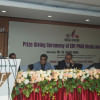What are its shortcomings?
It is apparent from the final draft of the Seventh Five Year Plan FY 2016-FY 2020 that the government has a clear vision for transforming the economy of Bangladesh from a rural-based agrarian economy into an urban-based industrial one. With a target of 8 percent GDP growth by 2020, the highly ambitious plan includes worthy initiatives like emphasising the incorporation of ICT, generating employment opportunities, and promoting gender equality. However, the plan has some shortcomings, especially when it comes to Technical and Vocational Education and Training (TVET).
The total number of polytechnic institutions enlisted by the Bangladesh Technical Education Board is 7,002, among which 293 are government organisations and 6,709 are private ones. According to the Labour Force Survey (LFS) 2010 by the Bangladesh Bureau of Statistics, 47.56 percent of the total employed population in Bangladesh is engaged in agriculture followed by 35.35 percent in the service sector and 17.52 percent in manufacturing and other industries. The vision of the government is in tune with this trend. The question is whether the goals and plans set by the government in the Seventh FYP are complying with this vision.
The report that has been produced by General Economics Division (GED) of the Planning Commission, as a background study for the Seventh FYP, written by Binayak Sen and Mahbubur Rahman, acknowledges the fact that agricultural modernisation requires a modest human capital requirement but when an economy is striving to be industrial, the 'skills-mix' should look very different. It clearly states that "only emphasis on below-primary or primary education will not be enough in this growth scenario; the focus needs to be given to secondary and technical education commensurate to the demand of the export-led labour-intensive manufacturing growth. Again, if the stage of growth is shaped predominantly by the service sector growth, the emphasis needs to be shifted to post-secondary and higher technical education and training." A mismatch between demand and supply of skills might be very costly for Bangladesh at this stage. The final draft of the Seventh FYP should have reflected this statement from its own background study on the whole but has disappointed its audience in many ways.
In the 'Plan Goals and Targets' part of the draft, for instance, there are only two targets dedicated to education and none of them talks about TVET. ICT has been heavily incorporated in various parts of the plan, including secondary, higher and madrasa education but not TVET.
One of the most crucial exercises while drafting such a plan is to analyse past failures and attainments. The chapter on 'Progress with TVET during the Sixth Plan' is quite vaguely written, lacking in proper statistical representation, analysis and interpretation. Likewise, the 'Major Challenges' part should have been more specific and backed by necessary data like the ones presented in other streams of education except technical and vocational education and training! Similarly, the 'resource allocation' part of the plan does not extensively explain how much budget will be provided for the TVET sector over the next five years. Also the issue of research and knowledge development in the TVET sector of Bangladesh has not been seen in the report. These shortcomings in preparation and presentation of the report can thus be (mis)interpreted by the audience of the plan as lack of research or attention to this sector.
The plan fortunately acknowledges the skills deficiency of migrant workers and has provided plans for training people for overseas employment. It also recognises the promotion of gender equity and special attention to disadvantaged groups and persons with disabilities.
It is apparent from the final draft of the Seventh FYP that the government will be heavily dependent on the National Skill Development Policy (NSDP 2011) for the development of the TVET sector. However, instead of repeating the words from the policy paper, the plan could have been given a structured direction toward how these policies are going to be implemented with time bound targets. A constructive way to develop targets and goals is to follow the SMART criteria used by George T. Doran in his paper published in Management Review in 1981. SMART stands for: Specific – target a specific area for improvement; Measurable – quantify or at least suggest an indicator of progress; Assignable – specify who will do it; Realistic – state what results can realistically be achieved, given available resources; Time-related – specify when the result(s) can be achieved.
In order to avoid the mismatch of supply and demand of skills, it is important to plan from a demand-side point of view. Thus developing linkages between industries and polytechnics is a critical pre-requisite. The responsibility of the National Skill Development Council (NSDC), chaired by the honourable Prime Minister, is to promote technical and vocational education in close cooperation with industry, and handling the routine coordination with all the Industrial Sector Councils (ISCs). The role of the NSDC has unfortunately been missing from the Seventh FYP. It could have explicitly specified some targets to be fulfilled by this body over the next five years. The NSDC can contribute greatly in fulfilling the target of generating 13 million jobs which has been one of the highlights of the Seventh FYP.
Policies and interventions alone cannot bring change in society. In Bangladesh, the profile of a TVET student is perceived as male, poor and 'left-out' from the general education stream. This long-established misconception needs to be rectified. The government and development agencies, through a planned social marketing approach, can promote the message that students of TVET can be well-earning, respected members of the society, that they can be employers and entrepreneurs.
The Sustainable Development Goals (SDGs) have stressed the importance of TVET under Goal 4, which aims to substantially increase the number of youth and adults who have relevant technical and vocational skills, for employment, decent jobs and entrepreneurship by 2030. Also, according to the SDG targets, the technical and vocational students of the LDCs are expected to be given a substantial number of scholarships by the developed nations by 2020. The Seventh FYP can be a head start for achieving these targets.
The importance and potential of the TVET sector is undeniable at this stage. Since the Seventh FYP is still a 'draft' and there is still scope for adjustments and improvements, the GED of the Planning Commission might consider revising the TVET part of the plan so that it becomes a complete guideline for the development of TVET and the system can be held accountable for its progress over the next five years.
The writer is Research Assistant, Education Global Practice, The World Bank, Bangladesh.

 For all latest news, follow The Daily Star's Google News channel.
For all latest news, follow The Daily Star's Google News channel. 








Comments